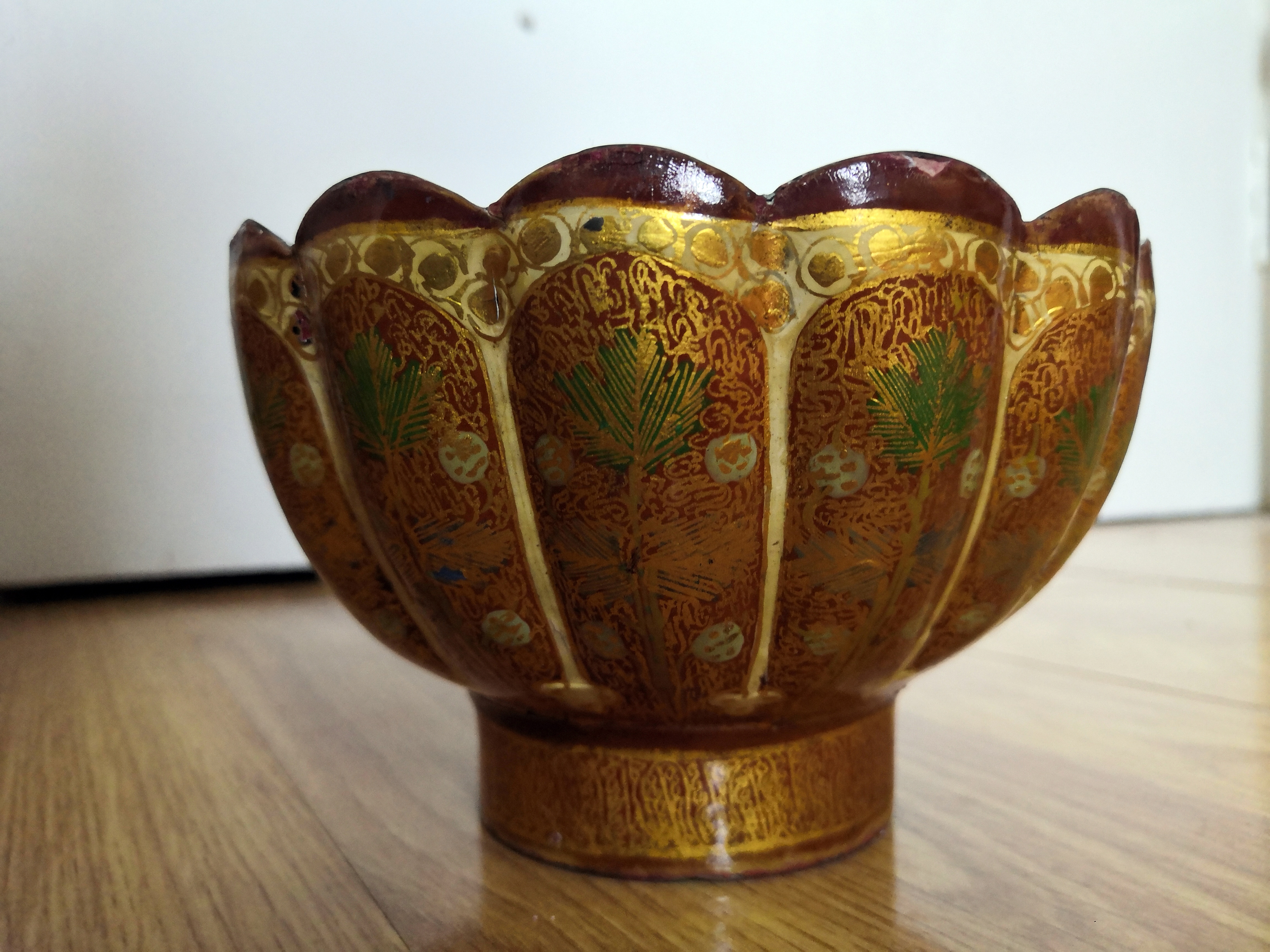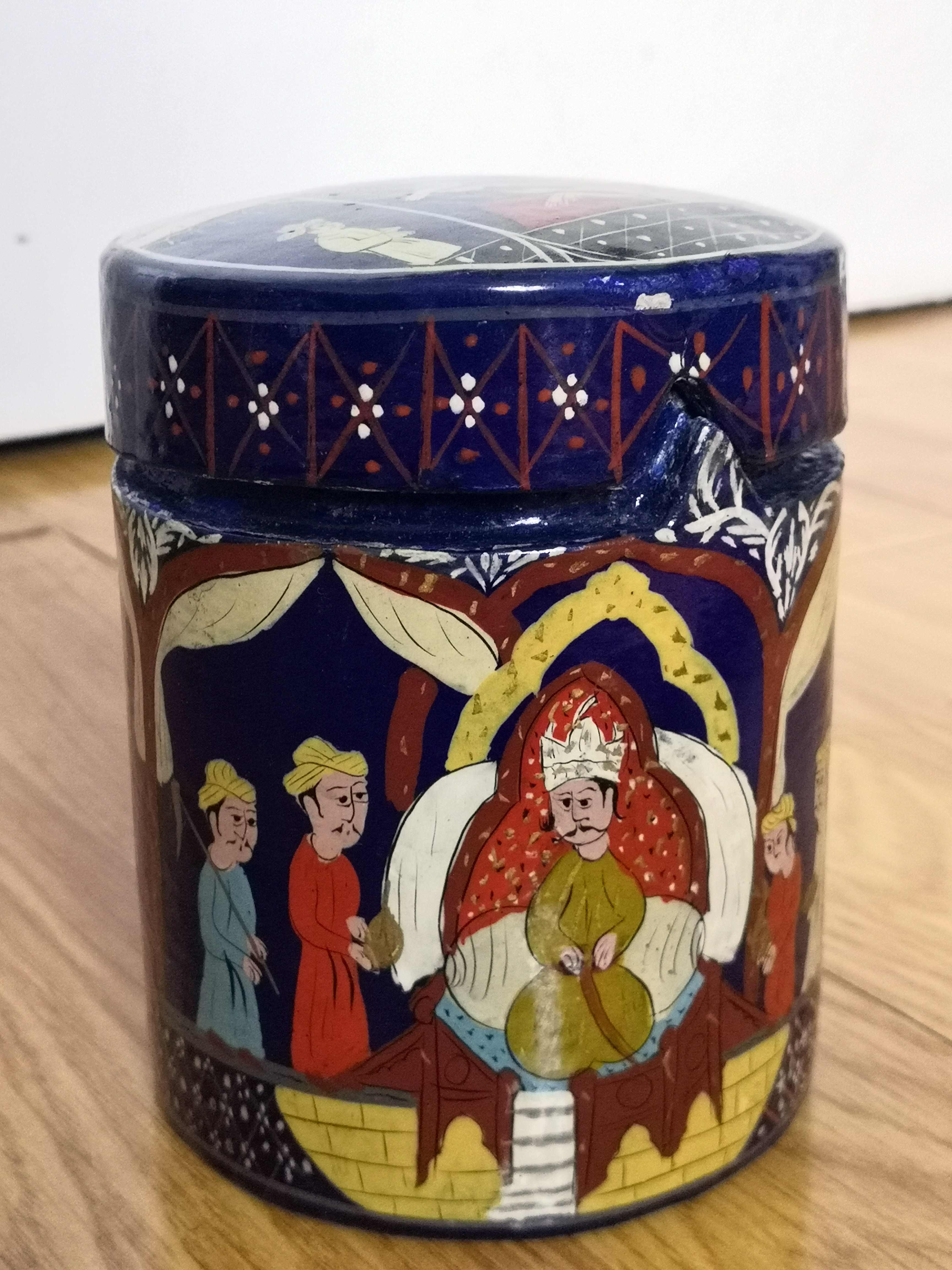By Samiya Younis
Learn about Kashmiri crafts and how to share a narrative through 3D design.
Don’t forget to share your bowl or post online and tag @natsatclub

Overview
Kashmiri papier-mâché craft (made out of waste paper) has been passed down from generation to generation for centuries. The origin dates back to as early as the 15th century. It was highly popular during the Mughal rule in India.
How is it made?
It is a very time consuming process which requires precision and two main steps. Sakthsazi (making of the actual item) and Naqashi (the painting and decoration part)
Kashmiripapier-mâché decorative items range from bowls, coasters, jewellery boxes, frames and storage boxes, to trays, stools, tables, and much more. They are beautifully decorated by hand with motifs, designs inspired by the Mughal ere often depicting scenes from Mughal court, people, flowers within flowers, birds, jungle scenes, geometric designs and much more. Each piece has a unique storey to tell.
Examples of Kashmiri papier-mâché designs.
With this in mind I would like you think about what kind of narrative/story you could bring into decorating your Kashmiri inspired bowl.
Maybe it could be:
• A narrative/story from your family history or culture, depicting people, animals or objects in a scene
• It could be your account of an event, or an experience that means a lot to you
• You could use photographs as reference points
• Create a fictional imaginative scene
It’s your story, so make it personal to you!

Materials
- White flour
- Water
- Newspaper
- Cereal bowl (mould)
- Thin bin liner bag
- Masking tape
- Acrylic paints
- Paint brush (different thickness)
- Empty Paper cups or yogurt pots for mixing paint
- Scissors
- Large Bowl (for mixing)
- Spoon
Activity part one – Sakthsazi (Making of the actual item)
Step 1: Making the papier-mâché paste
Mix equal parts flour and water in a bowl stirring the mixture until it is smooth and silky. For example 1.5 cup of water and 1.5 cup of flour.
Step 2: Newspaper
Cut the newspaper into long thin strips to fit around the bowl.
Step 3: Covering the outside of the cereal bowl
Turn the cereal bowl upside down with the bottom facing upwards. Cover your bowl with a thin plastic bag like a small bin liner and apply two strips of masking tape across it like this. This helps to keep the bag secure.

Dip the newspaper strips into flour and water paste. Ensure it is all covered. Slide it through your fingers to get rid of any excess paste. Then lay it over your bowl. Repeat this process until the outside of the bowl is covered with two layers. If you want it to be stronger then add another two layers.
Step 4: Leave the bowl to dry over night.
Activity part two – Naqashi (the painting and decoration part)
Step 5: Remove
Remove the dry paper cast from the mould. You can then either trim the edges of the papier-mâché bowl with scissors or cut a design around the rim.
Step 6: Base Layer
Paint the whole bowl with an opaque colour of your choice so that it stops the newspaper print from showing through but it also gives you a clean canvas to work on. Start from the outside, add more layers of paint if you need to and leave it to dry.
Step 7: Decorate
Once dry decorate your bowl how you would like to using acrylic paints or pens. It may be useful to sketch out your ideas first onto the bowl keeping in mind the narrative/story telling theme. You could apply some of the drawings skills you have learnt in your Saturday Clubs.
Step 8: Outcome
Finished decorating your Kashmiri inspired papier-mâché bowl.
Share your bowl or post online and tag @natsatclub and [institution instagram]
Thank you for taking part in the University of Arts London Saturday Club Workshop.
Resources & References
History and information on Kashmiri bowls
Book Reference:
J. Jaitly. (1999) Crafts of Jammu, Kashmir & Ladakh. Middletown USA: Grantha Corporation.
Contributed by Samiya Younis, University of Arts London Art&Design Saturday Club
Samiya is a Saturday Club Tutor at Central Saint Martins and is working for CCW Outreach team to support students in HE Colleges develop their ideas and skills within Art and Design at a stage where they are thinking about transitioning into FE and applying to HE. Samiya is also currently doing her PgCert in Academic Practice in Art, Design and Communication with an electric unit in Inclusive Learning and Teaching here at UAL. Samiya is also a freelance artist/curator, working in visual media specialising in sculpture.
‘This programme has really challenged club members creativity. It has pushed them to experiment and explore drawing in ways they have not explored before. It has challenged them to think and work outside the box, work in large scale with creative industry professionals and work alongside other club members’